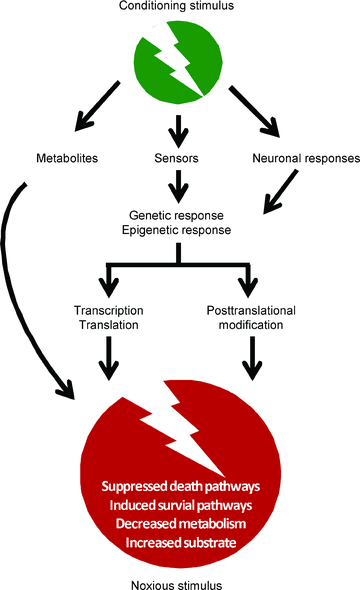Protective conditioning of the brain: expressway or roadblock?
- PMID: 21708907
- PMCID: PMC3180575
- DOI: 10.1113/jphysiol.2011.209718
Protective conditioning of the brain: expressway or roadblock?
Abstract
The brain responds to noxious stimulation with protective signalling. Over the last decades, a number of experimental strategies have been established to study endogenous brain protection. Pre-, per-, post- and remote 'conditioning' are now widely used to unravel the underlying mechanisms of endogenous neuroprotection. Some of these strategies are currently being tested in clinical trials to protect the human brain against anticipated damage or to boost protective responses during or after injury. Here we summarize the principles of 'conditioning' research and current efforts to translate this knowledge into effective treatment of patients. Conditioning to induce protected brain states provides an experimental window into endogenous brain protection and can lead to the discovery of drugs mimicking the effects of conditioning. Mechanisms of endogenous brain tolerance can be activated through a wide variety of stimuli that signal 'danger' to the brain. These danger signals lead to the induction of regulator and effector mechanisms, which suppress death and induce survival pathways, decrease metabolism, as well as increase substrate delivery. We conclude that preclinical research on endogenous brain protection has greatly benefited from conditioning strategies, but that clinical applications are challenging, and that we should not prematurely rush into ill-designed and underpowered clinical trials.
Figures


Similar articles
-
Endogenous neuroprotection: mitochondria as gateways to cerebral preconditioning?Neuropharmacology. 2008 Sep;55(3):334-44. doi: 10.1016/j.neuropharm.2008.02.017. Epub 2008 Mar 8. Neuropharmacology. 2008. PMID: 18402985 Review.
-
Ischemic conditioning-induced endogenous brain protection: Applications pre-, per- or post-stroke.Exp Neurol. 2015 Oct;272:26-40. doi: 10.1016/j.expneurol.2015.04.009. Epub 2015 Apr 18. Exp Neurol. 2015. PMID: 25900056 Free PMC article. Review.
-
Preconditioning and postconditioning: underlying mechanisms and clinical application.Atherosclerosis. 2009 Jun;204(2):334-41. doi: 10.1016/j.atherosclerosis.2008.10.029. Epub 2008 Nov 5. Atherosclerosis. 2009. PMID: 19081095 Review.
-
Ionic homeostasis in brain conditioning.Front Neurosci. 2015 Aug 10;9:277. doi: 10.3389/fnins.2015.00277. eCollection 2015. Front Neurosci. 2015. PMID: 26321902 Free PMC article. Review.
-
Sodium/calcium exchanger as main effector of endogenous neuroprotection elicited by ischemic tolerance.Cell Calcium. 2020 May;87:102183. doi: 10.1016/j.ceca.2020.102183. Epub 2020 Feb 17. Cell Calcium. 2020. PMID: 32120196 Review.
Cited by
-
An active component of Achyranthes bidentata polypeptides provides neuroprotection through inhibition of mitochondrial-dependent apoptotic pathway in cultured neurons and in animal models of cerebral ischemia.PLoS One. 2014 Oct 15;9(10):e109923. doi: 10.1371/journal.pone.0109923. eCollection 2014. PLoS One. 2014. PMID: 25334016 Free PMC article.
-
Training the brain to survive stroke.PLoS One. 2012;7(9):e45108. doi: 10.1371/journal.pone.0045108. Epub 2012 Sep 13. PLoS One. 2012. PMID: 23028788 Free PMC article.
-
Novel Treatments in Neuroprotection for Aneurysmal Subarachnoid Hemorrhage.Curr Treat Options Neurol. 2016 Aug;18(8):38. doi: 10.1007/s11940-016-0421-6. Curr Treat Options Neurol. 2016. PMID: 27325362 Review.
-
A concerted appeal for international cooperation in preclinical stroke research.Stroke. 2013 Jun;44(6):1754-60. doi: 10.1161/STROKEAHA.113.000734. Epub 2013 Apr 18. Stroke. 2013. PMID: 23598526 Free PMC article. No abstract available.
-
A functional role of the cyclin-dependent kinase inhibitor 1 (p21(WAF1/CIP1)) for neuronal preconditioning.J Cereb Blood Flow Metab. 2013 Mar;33(3):351-5. doi: 10.1038/jcbfm.2012.213. Epub 2013 Jan 9. J Cereb Blood Flow Metab. 2013. PMID: 23299246 Free PMC article.
References
-
- Akira S, Takeda K. Toll-like receptor signalling. Nat Rev Immunol. 2004;4:499–511. - PubMed
-
- Bastide M, Gele P, Petrault O, Pu Q, Caliez A, Robin E, Deplanque D, Duriez P, Bordet R. Delayed cerebrovascular protective effect of lipopolysaccharide in parallel to brain ischemic tolerance. J Cereb Blood Flow Metab. 2003;23:399–405. - PubMed
-
- Bernaudin M, Tang Y, Reilly M, Petit E, Sharp FR. Brain genomic response following hypoxia and re-oxygenation in the neonatal ratIdentification of genes that might contribute to hypoxia-induced ischemic tolerance. J Biol Chem. 2002;277:39728–39738. - PubMed
-
- Bøtker HE, Kharbanda R, Schmidt MR, Bøttcher M, Kaltoft AK, Terkelsen CJ, et al. Remote ischaemic conditioning before hospital admission, as a complement to angioplasty, and effect on myocardial salvage in patients with acute myocardial infarction: a randomised trial. Lancet. 2010;375:727–734. - PubMed
-
- Chan MT, Boet R, Ng SC, Poon WS, Gin T. Effect of ischemic preconditioning on brain tissue gases and pH during temporary cerebral artery occlusion. Acta Neurochir Suppl. 2005;95:93–96. - PubMed
MeSH terms
LinkOut - more resources
Full Text Sources

